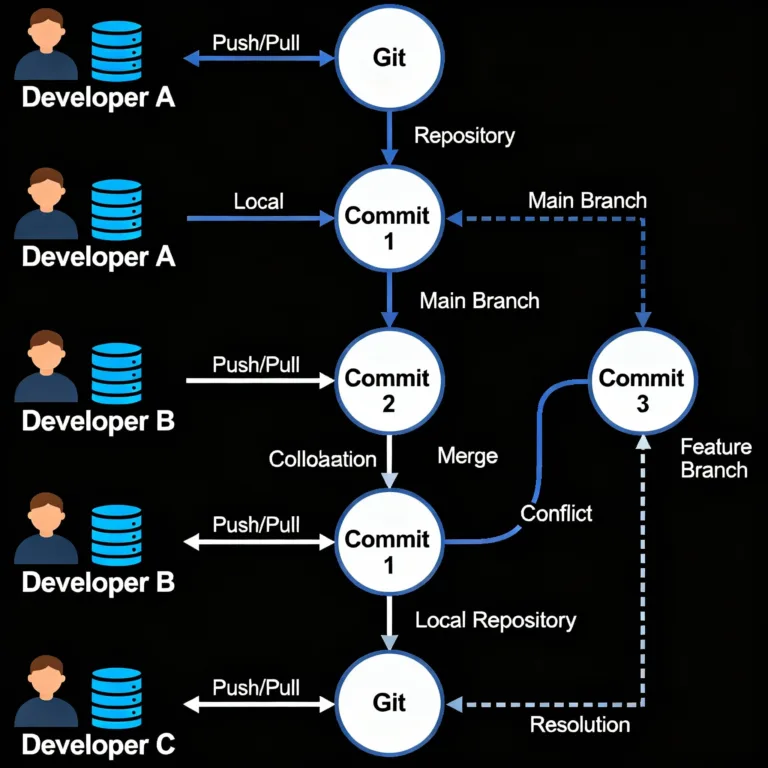What is Git ?
Git is a distributed version control system (VCS) that is used to track changes in source code during software development. It allows multiple developers to work on a project simultaneously without interfering with each other’s changes. Git records changes to a repository, enabling developers to revert to previous states, compare changes over time, and collaborate more efficiently.
At its core, Git manages a project or a set of files as they change over time. It stores this information in a data structure called a repository. Git’s distributed nature means that every developer has a full copy of the entire repository, including its complete history, on their local machine.

Origin and History
Git was created by Linus Torvalds in 2005 for the development of the Linux kernel. Before Git, the Linux kernel project relied on a proprietary version control system called BitKeeper. In 2005, when the relationship between the Linux community and the makers of BitKeeper broke down, Torvalds decided to develop a new VCS that would meet the needs of the kernel developers.
Torvalds designed Git with the following goals in mind:
- Speed: Git is optimized for performance.
- Simple design: The architecture is straightforward, making it easy to understand and use.
- Strong support for non-linear development: Git supports branching and merging, which are common in modern software development.
- Fully distributed: Every developer has a full copy of the repository.
- Able to handle large projects like the Linux kernel efficiently.
The initial release of Git was in April 2005. Since then, it has grown in popularity and has become the most widely used version control system in the world, particularly in the open-source community.
Features
- Branching and Merging: Git allows for easy branching and merging, enabling developers to work on multiple features or bug fixes simultaneously and merge changes seamlessly.
- Distributed Development: Each developer has a complete local copy of the repository, allowing for offline work and reducing dependency on a central server.
- Staging Area: Git includes a staging area (or index) where changes can be reviewed and modified before they are committed to the repository.
- Commit History: Git maintains a detailed history of changes, including who made each change and why.
- Efficient Storage: Git uses a combination of techniques such as compression and delta encoding to efficiently store changes.
- Data Integrity: Every file and commit is checksummed using SHA-1 hashes, ensuring the integrity of the repository.
- Support for Multiple Workflows: Git supports various workflows, including centralized, feature branch, and Gitflow, making it versatile for different development practices.
Advantages
- Speed and Performance: Git is designed to handle everything from small to large projects with speed and efficiency.
- Collaboration: Git’s branching and merging capabilities make it easy for teams to collaborate on the same codebase.
- Flexibility: Developers can create branches for new features, bug fixes, or experiments without affecting the main codebase.
- Data Integrity: Git ensures the integrity of the source code with its robust hashing mechanism.
- Offline Work: Developers can perform most operations locally without needing a network connection.
- Widespread Adoption: Git’s popularity means there is extensive documentation, community support, and a wealth of tools and integrations available.
Drawbacks
- Complexity: Git’s powerful features can be overwhelming for beginners. The learning curve can be steep.
- Storage Overhead: While efficient, the full history of a project can consume significant disk space, especially for large repositories.
- Distributed Nature: While beneficial, the distributed nature can lead to conflicts and complications if not managed properly.
- Command Line Interface: Although there are graphical interfaces available, much of Git’s functionality is accessed through the command line, which can be intimidating for new users.
- Merge Conflicts: Complex merges, especially in large teams, can lead to conflicts that require manual resolution.
Git's combination of speed, performance, and flexibility has made it the de facto standard for version control in the software industry. Its ability to handle complex workflows and large projects efficiently has made it indispensable for modern software development. Despite its complexity, the advantages it offers far outweigh the drawbacks, making it an essential tool for developers worldwide.Happy coding !❤️
